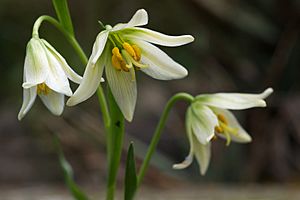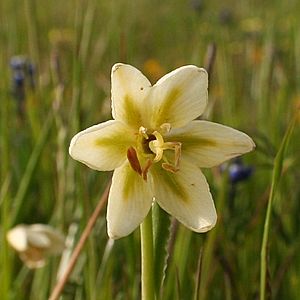Fragrant fritillary facts for kids
Quick facts for kids Fragrant fritillary |
|
|---|---|
 |
|
| Scientific classification | |
| Kingdom: | |
| (unranked): | |
| (unranked): | |
| Order: | |
| Family: | |
| Genus: |
Fritillaria
|
| Species: |
F. liliacea
|
| Binomial name | |
| Fritillaria liliacea |
|
| Synonyms | |
|
|
The Fritillaria liliacea, also known as the fragrant fritillary, is a special plant in the lily family. It is a perennial herb, which means it's a plant that lives for more than two years and doesn't have a woody stem. This plant grows naturally around the San Francisco Bay area in California. Sadly, it is a threatened species, meaning it is at risk of disappearing.
What It Looks Like
The Fragrant fritillary has beautiful white flowers that are shaped like bells. These flowers often have greenish stripes. They grow on a stem called a "pedicel" that can be about 37 centimeters (about 14.5 inches) tall. The flowers might not smell like anything, or they might have a very light, pleasant scent.
This plant likes to grow in heavy soils, like clay. It especially likes soils that come from old volcanic rocks. These types of soils are found in places like the Sonoma area.
Where It Grows and Why It's Special
This wildflower grows in parts of southwestern Northern California, United States. You can find it in Solano and Sonoma counties. It also grows along the coast as far south as Monterey County. It usually lives in open, hilly grasslands that are less than 200 meters (about 650 feet) above sea level.
The Fragrant fritillary is an "endemic" plant. This means it only grows naturally in California and nowhere else in the world. Because it's so rare, it has been considered for protection as a U.S. federally endangered species. Some of the places where it still grows are very small and spread out. This puts the plant at risk of "local extinction," meaning it could disappear from those specific areas.
For example, you can find some of these plants in Edgewood County Park in San Mateo County. They also grow in the foothills of the Sonoma Mountains in Sonoma County. However, in San Francisco, many groups of these plants have disappeared because of city development.


